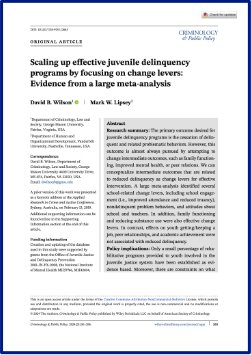By Hannah Sutherland, Jessica Norton, Danielle Munguia, Trevor Fronius
Research on the factors that contribute to male gang involvement is extensive and varied. It includes studies of environmental, cultural, and social factors that increase the risks of gang involvement or lead to gang involvement, including how these factors vary by race and ethnicity. These factors are typically referred to as “push” and “pull” factors. Push factors are external to the gang (e.g., history of abuse, lack of parental support or supervision) and push an individual toward membership, and pull factors are internal to the gang (e.g., street credibility, protection, economic benefits) and draw an individual into membership. This paper extends the focus on push and pull factors by providing a systematic review of research from the past decade specific to female gang involvement. Until recently, research on the roles of females in gangs has been minimal because violence and gang membership have historically been thought to be male-dominated phenomena (Esbensen et al., 1999). Females have commonly been thought to be auxiliary members or nonactive members because of the roles they would stereotypically inherit or be placed into by male gang members. For example, initial research on the female roles within gangs was focused on narrow parameters regarding what constitutes an appropriate or even possible set of gang activities for girls and women (Coughlin & Venkatesh, 2003). These activities were usually based around sexual favors to their male counterparts, weapon concealing, drug carrying, and whatever else may be instructed to them by the dominant males. Furthermore, longitudinal research has not been conducted on the push and pull factors that attract females to gang involvement. Often this research has disregarded gender differences when observing push and pull factors by assuming factors were the same across genders. Additionally, insight into female gang involvement has often reflected male-gendered perspectives, suggesting a deficit model for gang affiliation and engagement (Deuchaur et al., 2020). However, some literature has provided fresh perspectives that argue that female gang affiliation is much more “agentic” than previously thought (Bandura, 2001). For instance, Moore and Hagedorn (2001, p. 3) found that gang membership can be viewed as an “assertion of independence” from familial, cultural, and class constraints. In this way, the gang lifestyle offers females empowerment and the prospect of individualism that counters previously reflected gendered perspectives that suggested a deficit model of gang affiliation and engagement (Deuchar et al., 2020). In a qualitative comparative study, Deuchar and colleagues (2020) compared female gang involvement in Los Angeles and Glasgow and found that the method of entry and point of entry into gangs were especially important to female respondents. Their entry determined not only how they were viewed, categorized, and perceived by their male counterparts but also how they were positioned within their own street gang hierarchy. This finding challenges the common assumption that females join gangs to be affiliated with male gangs. In fact, it could be argued that street gangs offer females a variety of reasons for joining—for some, gang affiliation is a way to escape from past experiences; for others, gang affiliation is a way in (i.e., past experiences have normalized gang involvement); and for others, gang affiliation may be a way of achieving social mobility and power (Deuchar et al., 2020). Although some factors may be similar for male and female gang involvement, others may be uniquely identified by expanding the research on female gang involvement. To start, numerous studies have demonstrated that females involved in gangs experience different forms of and more severe victimization than do their male counterparts (Klein & Maxson, 2006; Sutton, 2017; Valasik & Reid, 2019). For example, studies show that many female gang members experience an excessive amount of victimization early in life, even prior to joining a gang (Sutton, 2017). Female gang members often have a history of physical and sexual abuse at home by older male figures who are either family members or family friends (Valasik & Reid, 2019). This victimization is known to continue in various forms between female and male gang members upon joining a gang. Once they join a gang, females are at increased risk of being victimized, especially sexually, by older male counterparts in the gang (Valasik & Reid, 2019). They are also at increased risk of being forced by established female gang members to have sex with multiple male members (Gibson et al., 2012). This form of victimization is rarely experienced by male gang members and is uniquely identified in female gang members. Moreover, another stark gender difference between males and females is that females who experience a lack of family support are at increased risk of joining a gang to fulfill their desire of having an emotionally satisfying familial group, while males are typically seeking adventure and excitement in gang lifestyle and relationships (Valasik & Reid, 2019). Common gang-involved factors such as street status, protection, physical and sexual victimization, delinquency, lack of parental monitoring or support, and a craving for an emotionally satisfying familial peer group are only a few mentioned factors that are not completely generalizable across genders (De La Rue & Espelage, 2014; Deschenes & Esbensen, 1999; Deuchar et al., 2020; Esbensen et al., 1999; Gold, 2000; Simon et al., 2013). In his early research, Gold explored power and status as prominent pull factors due to the significant number of females who join gangs because of limited opportunities in their homes and communities that in turn push them toward gang involvement. His research around female gang involvement showed that roles for female gang members have expanded, and they are no longer viewed as just sexual objects or the girlfriends of male gang members; they have gained their own gang autonomy and control (Gold, 2000). In addition, Gold (2000) researched the ways in which peer relationships among females are fostered in gangs and how such relationships influence their decision to join, stay, and pressure other peers to conduct delinquent activities. Some scholars suggest that females can perceive gangs and gang life as a source of empowerment. According to Gold (2000), many females perceived the gang as a place where they could gain some power and control over their lives. Relatedly, Curry (1998) has suggested that it is important to develop a feminist perspective in order to formulate more useful observations and theories about female gang involvement that counter the initial, hegemonic, male-centered view of gang lifestyle. In other words, a feminist perspective could limit the generalizations made about factors that influence females to join gangs and facilitate a greater inclusion of relevant environmental, cultural, and social factors that promote female gang involvement. The sections that follow describe why and how a systematic review of relevant literature was conducted and then provide a synthesis of the quantitative empirical literature on push and pull factors that influence females to join gangs and on collateral involvement in sex trafficking.
Boston: Massachusetts Executive Office of Health and Human Services, Office of Children, Youth and Families. 2024; 32p.





